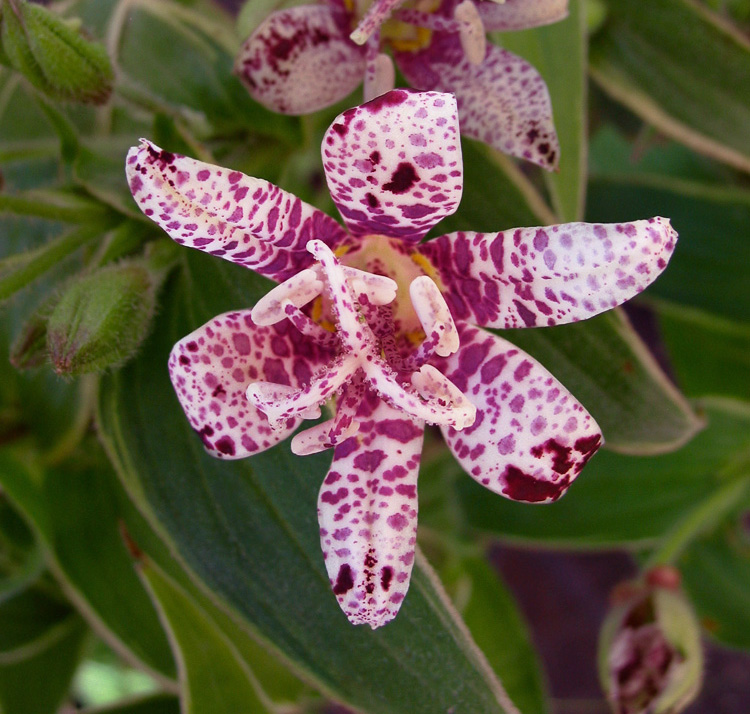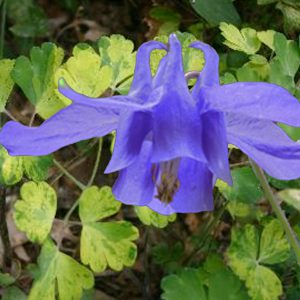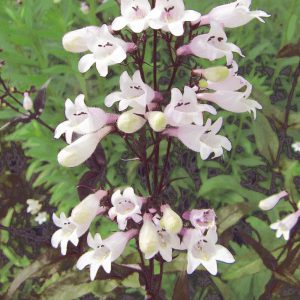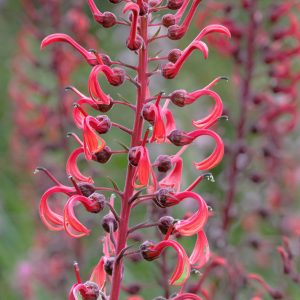- 1-9 pkts $4.50
- 10 pkts FREE
- Express post $12
Tricyrtis hirta ‘Miyazaki’
DWARF SPOTTED TOAD LILY
Tricyrtis hirta ‘Miyazaki’ is, in my humble opinion – the best of all the Toad Lilies.
Spectacular orchid-like blooms by mid-autumn
Just when all the other plants seem to be exhausted after summer, ‘Miyazaki’ shines at her best.
Large sprays of spotted orchid blooms
Flowers are large, orchid-like, ivory-white, with deep purple spots.
(Hence the common name of Toad Lily, but they are not Lilies and certainly not orchids).
And borne in large sprays held well above the foliage on elegantly arching stems
Weather hardy blooms late in the season
The blooms also have a substantial, wax-like texture which makes them very weather hardy, staying crisp through the even worst weather autumn can chuck at them.
Dwarf arching Toad Lily perfect for small gardens or pots
‘Miyazaki’ really is the perfectly behaved Toad Lily for me.
Some of the others are tall, sprawling, and even invasive – too much of a good thing.
But ‘Miyazaki’ is shorter and neater, with an elegant arching habit.
Making a clump of approx. 60cm. high x 50cm. wide.
And the plant stays as a neat clump – it is not invasive.
Large showy blooms on a compact plant
While the flowers are bigger and much showier than any other of the Toad Lilies.
So Tricyrtis hirta ‘Miyazaki’ is the perfect plant for small gardens or pots in the shade, or mass planted under trees and shrubs in larger gardens.
Elegant sprays cut for autumn vases
The arching stems of Tricyrtis hirta ‘Miyazaki’ make wonderful cut flowers for autumn floristry and arrangements. Very showy and unusual with their heavy spotting.
The thick waxy flower petals give blooms a good vase life.
While the ladder like foliage is easy to clean from the stems
Beauty in deep shade or part shade
Tricyrtis hirta ‘Miyazaki’ thrives in permanent full shade, in the shade under both evergreen or deciduous trees, and in dappled light and shade.
Very handy bloomer for all shaded locations, but it dislikes too much sun.
Thrives under trees & shrubs
‘Miyazaki’ is native to woodlands in Japan.
So it naturally thrives under trees and shrubs, where it enjoys organic matter, leaf litter and mulch.
In these conditions it is not a thirsty plant, and does not need lots of watering – mulch helps to retain moisture in the soil. So it can tolerate some periods of dry, with mulch.
It settles well into a wide range of soils, from sandy to heavy loam, with a wide range of pH from acid to alkaline. And it also enjoys reasonable drainage.
So it is easily pleased.
Hardy in both winter frost & summer heat & humidity
Toad Lilies are naturally adapted to areas with cold and frosty winters, as well as hot and/or humid summers.
So ‘Myazaki’ is frost hardy down to at least -20°C, and providing it is in shade it can tolerate summer heat well, and relishes humidity.
Low maintenance & pest/disease free
Very little ever troubles a Toad Lily, and they are unlikely to give you any work.
They are largely free from any pests and diseases, and ‘Myazaki’ is considered a particularly tough, easily grown Toad Lily. It is an award winner for hardiness.
And if you wish to tidy during winter, you can cut the spent stems back the the carpet of leaves at ground-level.
Bees, butterflies and native honey-eater birds
love the nectar for winter
Both our native bees and honey-bees, plus the butterflies and pollinators, plus our native Honeyeater birds – are all thankful for the nectar rich Toad Lily blooms in autumn.
It helps them to plump up for winter.
Deer proof
Toad Lilies are not tasty to deer, though rabbits may take a nibble.
SEED SOWING ADVICE:
Sow any time indoors in punnets, whenever suitable temperatures can be provided (see below).
OR
Scatter directly in garden in autumn ready for spring germination.
Sow indoors for quicker and maximum germination: First sow the seeds in a punnet on the surface of good quality seed raising mix.
Tip for sowing fine seed: The seed for Tricyrtis is very fine.
So finely sieve a few pinches of seed raising mix, then put it into the plastic storage bag with the seed. Shake well, then sow the full contents of the bag.
This will help you gather up all the seed and spread it more evenly.
Then just lightly pat the seeds to the surface of the mix but do not cover.
Because these seeds need light to germinate.
Now thoroughly moisten the punnet by standing it in a shallow water bath.
And allowing the moisture to percolate up to the surface of the mix from below.
Now drain and wrap the moist, sown punnet in cling-wrap or a clip-lock bag, and place in the fridge (not freezer) for 4-6 weeks.
This mimics a nice cold winter.
(Or you can sow in autumn then just leave them out in the cold for the winter – but do remember to water regularly).
Then remove from fridge, unwrap, re-moisten and place the punnet in a warm, well-lit position (with good light but no direct sunlight).
Temperatures of 18-20°C approx. are ideal for rapid and optimum germination.
Continue to keep the punnet moist by regularly misting the punnet from a spray water bottle.
Covering the punnet with a clear plastic cover will help to maintain necessary consistent moisture.
These seeds really respond to consistent moisture levels.
Seeds will germinate in 4-6 weeks.
But do not discard the punnet too quickly, as seeds will continue to germinate over a period. Which is normal for Tricyrtis hirta ‘Miyazaki’.
Once the seedlings have developed their first true leaves, prick out of the punnet into small pots and grow on until planting out into the garden.
Seed Count: 20 seeds per pack approx.
(We always aim to exceed the stated seed count, and give a generous serve).
Click here for Nursery Open Days & Open Gardens Information
https://www.gardivalia.com.au/open-gardens
Click here to go back to Seeds Shop
https://www.seedscape.net.au/shop/
Related products
-
Add to WishlistAlready In WishlistAdd to Wishlist
-
Add to WishlistAlready In WishlistAdd to Wishlist
-
Add to WishlistAlready In WishlistAdd to Wishlist
-
Add to WishlistAlready In WishlistAdd to Wishlist





